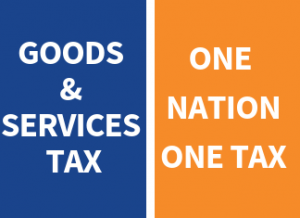What is GST?
GST stands for Goods and Services Tax which is an ‘indirect tax’ or ‘consumption tax’ levied in India on the supply of goods and services. It is levied at every step in the production process, but is meant to be refunded to all parties in the various stages of production other than the final consumer. It is named Goods and Services Tax as it is applicable on the supply of both ‘Goods and Services’.
GST or the Goods and Services Tax was introduced with the aim of replacing the multiple indirect taxes levied by State and Central Governments, in order to simplify the indirect tax system. GST has replaced almost 17 of the existing state and central indirect taxes, such as central excise duty, additional customs duty, VAT, entertainment tax, service tax etc.

THE LAUNCH OF GST
The Goods and Services Tax or GST was launched at midnight on 1 July 2017 by the President and the Government of India. The launch was marked by a historic midnight (30 June – 1 July) session of both the houses of parliament convened at the Central Hall of the Parliament.
It is one of the few midnight sessions that have been held by the parliament – the others being the declaration of India’s independence on 15 August 1947, and the silver and golden jubilees of that occasion. After its launch, the GST rates have been modified multiple times, the latest being on 22 December 2018, where a panel of federal and state finance ministers decided to revise GST rates on 28 goods and 53 services.
APPLICATION OF GST
The GST is imposed at variable rates on variable items. The rate of GST is 18% for soaps and 28% on washing detergents. GST on movie tickets is based on slabs, with 18% GST for tickets that cost less than Rs. 100 and 28% GST on tickets costing more than Rs.100 and 5% on readymade clothes.
The rate on under-construction property booking is 12%.Some industries and products were exempted by the government and remain ‘untaxed’ under GST, such as dairy products, products of milling industries, fresh vegetables & fruits, meat products, and other groceries and necessities.
TYPES OF GST:
We can broadly classify GST into four categories based on various parameters, as follows:-
- CGST – CGST is the acronym used for Central Goods & Services Tax. This is the tax
levied on the intrastate (within one state) supplies of goods and services by the Central government and is governed by the CGST Act. CGST replaces all the existing Central taxes including Service Tax, Central Excise Duty, CST, Customs Duty, SAD, etc.
Since GST is levied on consumption, the state where the product is originally manufactured is not entitled to the tax collected. If the manufacturing state levies a tax, the same will be transferred to the consuming state through the Central government.
- SGST – SGST stands for State Goods & Services Tax. It is levied on the Intra State supplies of both goods and services, by the state where the goods are being sold/purchased. It replaces all previously existing state taxes including VAT, State Sales Tax, Entertainment Tax, Luxury Tax, Entry Tax, State Cesses and Surcharges on any kind of transaction involving goods and services. Only the State Government can claim the revenue earned under SGST. It is governed by the SGST Act.
Both of these taxes are levied on intrastate supply of goods and supplies but governed differently, as by the ‘State Government’ in the case of SGST and by the ‘Central Government’ in case of CGST.
- IGST – IGST stands for Integrated Goods & Services Tax. It is applicable on interstate (between two states) transactions of goods and services, as well as on imports. This tax is collected by the Central government and is further distributed among the respective states. IGST is charged when a product or service is moved from one state to another. IGST has been introduced to make sure that a state has to deal only with the Union Government, and not with every other state separately to settle the interstate tax amounts.
- UTGST – UTGST stands for Union Territory Goods & Services Tax. The ‘Union Territory Goods and Services Tax’, commonly referred to as UTGST, is the GST applicable on the supply of the goods & services that takes place in any of the five Union Territories of India, including ‘Andaman and Nicobar Islands, Dadra and Nagar Haveli, Chandigarh, Lakshadweep and Daman and Diu’.
This tax will be levied in addition to the CGST whenever there is a transaction or exchange within a Union Territory.
The reason behind the introduction of UTGST separately was that the SGST / CGST cannot be applied to any of the Union Territories except Delhi & Puducherry, without a legislature. Both of these have their own legislatures, thus SGST is applied in this case.
Though GST is applicable to most of the goods and services, the rate slabs being varied, but there are some such items that are exempted from the tax.
Let’s look at some major goods & services exempted from GST and the various rate slabs:
GST TAX RATES & SLABS FOR VARIOUS GOODS & SERVICES (2019)
The GST council had revised the tax rates under GST as on January 18, 2018. The changes have been effective since 25 January 2018.
| 5 % Tax Applicable | LPG supplied to Household by Private Distributors,
Fertilizers, Biogas, Branded atta, Wheat, Pulses, Maida, Gram flour (besan), Railway freight, Footwear up to Rs. 500, Cotton and natural fibre, Outsourcing (in industries such as gems and jewellery, textiles), Railways (AC), Restaurants with annual turnover less than Rs. 50 lakhs, Cab aggregators like Ola, Uber, Airlines (Economy class), Non-AC restaurants without liquor license, Hotel room tariff Rs. 2,500 – 7,500, AC restaurants with liquor license. |
| 12% Tax Applicable | Small Old and Used Motor Vehicles, Packaged foods like pickles, tomato sauce, mustard sauce and fruit preserves, Ayurvedic and homeopathy medicines, Processed foods,Fruit juices, live animals, meats, butter & cheese, Mobile phones,Readymade garments, Pastries, cakes, pasta, ice creams, soups, Hotels with tariff Rs. 1,000 – 2,500, Real estate (Work contracts), State run lotteries, Airlines (Business class). |
| 18 % Tax Applicable | Telecom, financial services, Hotel room tariff above Rs.7,500,
Movie tickets below Rs. 100, Cement, wall putty, paint, wallpaper, Perfumes, revolver, pistols, Man made fibre and yarn, Medium and Large Old and Used Motor Vehicles, Buses which run on Biofuels,Computer printers, Footwear above Rs. 500, All FMCG goods like hair oil, soaps, toothpaste and shampoos; chemical and industrial use intermediaries, LPG stoves, military weapons, electronic toys, Chocolates, chewing gum, waffles containing chocolate, |
| 28% Tax Applicable | White and brown goods like TV, refrigerator, AC, Washing machines, Microwave ovens; soft drinks and aerated beverages, Movie tickets above Rs. 100, 5 star hotels, State authorized lotteries. |
| 31 % Tax Applicable | Heavy bikes, Luxury yachts,Private jets. |
| 3 % Tax Applicable | Gold, Silver. |
| 0.25% Tax Applicable | Diamond and Precious Stones |
| Other categories
28% + cess 28% + 1% cess 28% + 5% cess 28% + 15% cess |
|
| Exempted Goods | Essential farm produced mass consumption items like milk, cereals, fruits, vegetable, jaggery (gur), food grains, rice and wheat, Common use and mass consumption food items such as spices, tea, coffee, sugar, vegetable/ mustard oil; Newsprint, coal and Indian sweets, Silk and jute fibre, Sleeper, metro tickets and seasonal passes. |
Types of GST across the world
There are two types of GST systems across the world.
- Single unified GST Structure
- Dual GST Structure
India follows Dual GST Structure
Tax Laws before GST
In the earlier indirect tax regime, there were many indirect taxes levied by both the state and the centre. States mainly collected taxes in the form of Value Added Tax (VAT). Every state had a different set of rules and regulations.
Inter-state sale of goods was taxed by the centre. CST (Central State Tax) was applicable in the case of inter-state sale of goods. The indirect taxes such as the entertainment tax, octroi and local tax were levied together by state and centre. These led to a lot of overlapping of taxes levied by both the state and the centre.
For example, when goods were manufactured and sold, excise duty was charged by the centre for the inter-state movement. Over and above the excise duty, VAT was also charged by the state. It led to a tax on tax effect, also known as the cascading effect of taxes.
The following is the list of indirect taxes in the pre-GST regime:
- Central Excise Duty
- Duties of Excise
- Additional Duties of Excise
- Additional Duties of Customs
- Special Additional Duty of Customs
- Cess
- State VAT
- Central Sales Tax
- Purchase Tax
- Luxury Tax
- Entertainment Tax
- Entry Tax
- Taxes on advertisements
- Taxes on lotteries, betting, and gambling
- CGST, SGST, and IGST have replaced all the above taxes.
However, certain taxes such as the GST levied for the inter-state purchase at a concessional rate of 2% by the issue and the utilization of ‘Form C’ is still prevalent. It applies to certain non-GST goods such as:
- Petroleum crude;
- High-speed diesel
- Motor spirit (commonly known as petrol);
- Natural gas;
- Aviation turbine fuel; and
- Alcoholic liquor for human consumption.
- Resale
- Use in manufacturing or processing
- Use in certain sectors such as the telecommunication network, mining, the generation or distribution of electricity or any other power sector
What are the New Compliances Under GST?
Apart from the online filing of the GST returns, the GST regime has introduced several new systems along with it.
e-Way Bills
GST introduced a centralized system of waybills by the introduction of “E-way bills”. This system was launched on 1st April 2018 for inter-state movement of goods and on 15th April 2018 for intra-state movement of goods in a staggered manner.
Under the e-way bill system, manufacturers, traders and transporters can generate e-way bills for the goods transported from the place of their origin to their destination on a common portal with ease. Tax authorities are also benefited as this system has reduced time at check -posts and helps reduce tax evasion.
E-invoicing
The e-invoicing system was made applicable from 1st October 2020 for businesses with an annual aggregate turnover of more than Rs.500 crore in any preceding financial years (from 2017-18). Further, from 1st January 2021, this system was extended to those with an annual aggregate turnover of more than Rs.100 crore.
These businesses must obtain a unique invoice reference number for every business-to-business invoice by uploading it on the GSTN’s invoice registration portal. The portal verifies the correctness and genuineness of the invoice. Thereafter, it authorizes using the digital signature along with a QR code.
e-Invoicing allows interoperability of invoices and helps reduce data entry errors. It is designed to pass the invoice information directly from the IRP to the GST portal and the e-way bill portal. It will, therefore, eliminate the requirement for manual data entry while filing GSTR-1 (GST registered person) and helps in the generation of e-way bills too.
Important points on GST
Given below are a few important points on GST.
- The headquarters of the GST Council is located in New Delhi
- India’s GST is based on the Canadian Model.
- Assam is the first state in India to implement the GST bill
- France(follows Uniform GST) is the first country in the world to implement GST in the year 1954
- GST was introduced in the 101 amendment act
- India is the country with the highest GST rate in the world.
- Arun Jaitley, the Union Finance Minister was the chairperson of the GST Council.
- Currently, the GST council consists of 33 members headed by the current union Finance Minister Nirmala Sitharaman.
- GST was first proposed in India in the year 2000 by the Atal Bihari Vajpayee Government
- Indian GST model has four tax bands – 5%, 12%, 18% and 28%
- Currently, 160 countries in the world have implemented GST.
- The tax IGST is charged by the central government.
- The creation of the GST Council is as per Article 279A of the amended constitution.
- July 1 is celebrated a GST Day as per the announcement by the Central Board of Excise and Customs.
- Amitabh Bachchan is appointed as the brand ambassador of GST in India
- A country with a unified GST platform merges central taxes (e.g. sales tax, excise duty tax, and service tax) with state-level taxes (e.g. entertainment tax, entry tax, luxury tax) and collects them as one single tax.
- The Goods and Service Tax Network (or GSTN) is a non-profit, non-government organization. This portal will be used by the government to track every financial transaction and will provide taxpayers with all services – from registration to filing taxes and maintaining all tax details.
- GST is a destination-based tax on the consumption of goods and services. In destination-based taxation, exports are allowed with zero taxes whereas imports are taxed at par with domestic production.
- Cooking gas, Liquor, Petrol, air-fuel, natural gas and diesel are not covered under the GST.
OTHER IMPORTANT INFORMATION RELATED TO GST
KINDS OF TAXES
Direct Tax – This tax, as its name suggests, is levied directly on the income of an individual. The amount of tax payable varies on the income/profit earned by the individual from various sources such as salary, house rent income, etc. In simple words, the amount of tax you pay is directly proportional to your income, irrespective of the source.
Indirect Tax – As we can make out by the name, this kind of tax is not imposed directly on the income/profits of the individual. Instead, it is imposed on goods and services which in turn increases the cost (MRP) of those Goods and Services.
An indirect tax (such as sales tax, per unit tax, value-added tax ), or goods and services tax (GST) is a tax collected by an intermediary (such as a retail store) from the person who bears the ultimate economic burden of the tax (such as the consumer). The intermediary later files a tax return and forwards the tax proceeds to the government with the return.
Thus, we can say that taxes are one of the important factors that not only act as a source of revenue to the government but indirectly benefit the citizens of a country, through which the Government provides the basic necessary facilities to its citizens.
Also read –
IMEI Full Form with All Details
FULL FORM OF RBI взять займ без проверокпервый займ без процентов на 30 днейденьги сразу займ
Get Free Online Test Series, GK updates in form of Beepedia, BeeBooster, as well as latest updates for Bank PO, Bank Clerk, SSC, RBI, NABARD, and Other Government Jobs.















